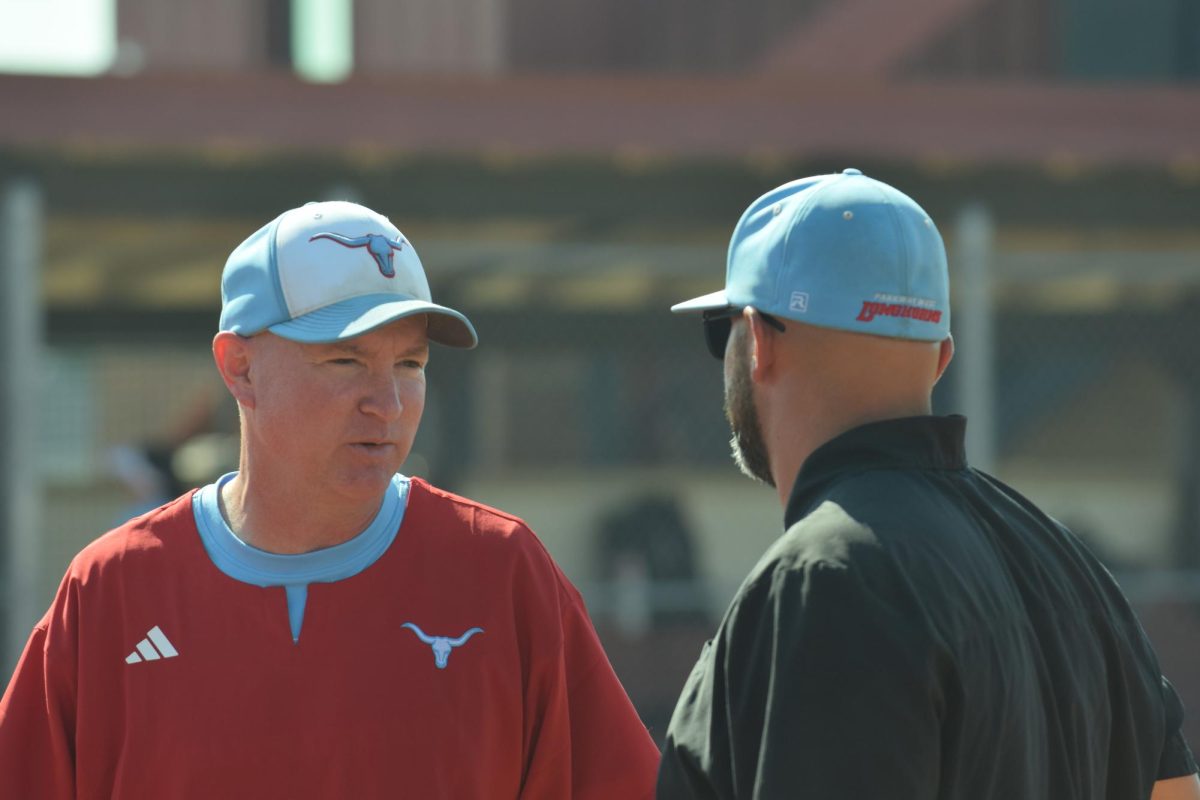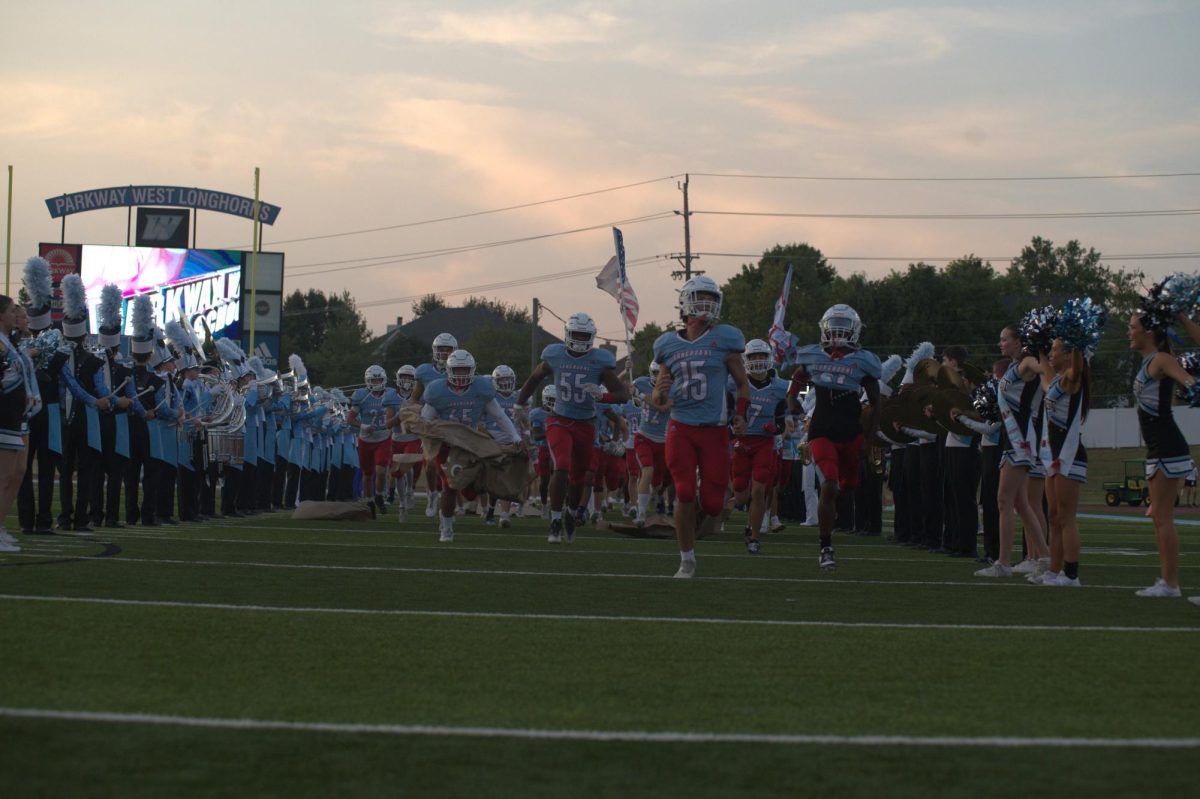Students at West High take pride in their extracurriculars, often showcasing their spirit on and off campus. However, this fall season, news of the recent discontinuation of junior varsity, freshmen or C-teams and restrictions on earning spots, have raised questions about player involvement тАФ and the lack of it.
Most recently, the softball program, returning from their final-four run in the state tournament, canceled their JV team due to a lack of turnout. Even after the teamтАЩs past success, multiple players chose not to try out for their second or third time. With 20 players showing up to tryouts, coaches couldnтАЩt form two 11 to 16 player rosters. Beyond players who received a roster spot, some athletes were cut and participated in team management instead.
тАЬThe worst thing in any program is having to make cuts,тАЭ assistant varsity softball coach and teaching assistant John Sloop said. тАЬWe wanted to have two teams because we’ve got some young kids that could benefit from the opportunities of the JV schedule. It became clear that playing two schedules wasn’t going to be a viable option especially because we had multiple injuries. We had to make tough decisions.тАЭ
Like softball, girls soccer, field hockey and both water polo programs lack a freshmen or C-team due to a lack of turnout. The shortage of athletes is a reflection of a broader issue pertaining to high school sports across the nation: according to the National Federation of State High School Associations, post-pandemic years show a decline in participation in traditional sports.┬а
тАЬWe have fifth to eighth graders coming up soon to play [high school] sports. We have numbers there.тАЭ Taggart said.тАЭHopefully, this is just a one-year thing and [player turnout] gets back to normal. It would be [ideal] to have three teams for every sport.тАЭ
Even though students have opportunities to be involved with athletics at a young age, not all of them choose to. The Aspen InstituteтАЩs annual report on trends in youth sports noted 27% of parents in 2022 cited a lack of interest as the reason their child, from the ages six to 18, is not involved in youth sports.┬а
тАЬWe can increase turnout by getting more people interested [in sports] at a very young level. There are so many options as far as what people can do. They can be involved with tons of sports or activities,тАЭ athletic director Jeff Taggart said.
To encourage sports participation from an early age, parents and athletes can look into West HighтАЩs summer youth sports camps which may elicit interest for participation later on in high school sports. Middle school programs are available during the school year for some athletics. Additionally, for the football program, there are non-school sponsored elementary and middle school feeder teams тАФ Jr Longhorns Football Club.┬а
тАЬItтАЩs tough to get kids to play football in high school if they haven’t done it before. ItтАЩs an uncomfortable sport,тАЭ physical education teacher and head football coach Jeff Duncan said. тАЬWe used to have really small numbers, and there were years where we couldn’t field a team. Now I think our numbers are strong in all of our grade levels. We are seeing increased participation due to the Junior Longhorn program.тАЭ
Even though their program doesnтАЩt extend to elementary schoolers, the softball program also offers the Junior Longhorn program for middle school students to get involved early on.
тАЬFor several years, weтАЩve had a Junior Longhorn softball program, so that kids are playing at younger ages,тАЭ Sloop said. тАЬIn the past, it has been a helpful driver in terms of creating numbers.тАЭ┬а
Freshman Carilynn Harfst was involved with the Junior Longhorns dance team throughout middle school before moving up to Longhorn Line, the high school varsity dance program. During her time with the Junior Longhorns, Harfst learned more about high school dance and learned from senior members.
тАЬThe Junior Longhorn dance team prepared me because it wasnтАЩt my first time dancing when I came to high school. Longhorn Line helped us out at our practices, so we knew how they did things. I knew what to expect,тАЭ Harfst said.
Another issue impacting high school sports is an abundance of athletes trying out for a single program. Unlike the other sports, girls volleyball makes multiple cuts every year due to a high number of players. Additionally, they have specific regulations as to which players can earn a spot on a specific team.┬а
тАЬUnfortunately, there’s a [limit on] the number of people that can play on a [volleyball] court,тАЭ math teacher and JV volleyball coach Kristen Judd said. тАЬHaving too many people on the court starts to become unsafe. You canтАЩt have more than 15 players on any team, but we try to have [fewer] because that [increases] playing time for individuals.тАЭ┬а
Historically, volleyball has only allowed freshmen on their freshmen team and only sophomores or freshmen on their JV team. These grade level constraints have resulted in multiple juniors being released from the program, as well as cuts across the board.
тАЬItтАЩs been a long time since we put juniors on JV. If we don’t see them taking a starting spot the next year, at the varsity level, then all we’ve done is extended their time but not allowed them to find something that they’re going to contribute to,тАЭ Judd said. тАЬItтАЩs just a reality of a sport where there are cuts. We spend a lot of time looking through things. When we make those decisions, we have the hard conversations and help them understand where it’s coming from.тАЭ
This balancing act reflects one of the core challenges of high school sports тАФ managing the number of players while also managing the quality of the team. While some programs face the tough reality of cutting players, others struggle to fill their rosters.┬а
Coaches and veteran players feel the reverberations of cuts, but for new and young players, there is a different set of challenges when trying out for a sport for the first time. The pressure, due to a variety of factors, can be immense, especially for those who havenтАЩt experienced high school sports before.
тАЬFor the young athlete, who maybe hasn’t experienced sports earlier, they may have a fear of getting cut,тАЭ Taggart said. тАЬThere are times [when] students are coming in to try out for sports for the first time, so they have all kinds of emotions.тАЭ
At times like tryouts, coaches are responsible for assessing the skill set of new players while also meeting the physical and emotional demands of an athlete. Clear communication between coaches and athletes plays a crucial role in such processes.┬а┬а
тАЬCoaches need to be somebody that’s going to be easy to talk to,тАЭ Taggart said. тАЬIndividuals coming in need [to] relax and take the pressure off of themselves. Tryout times are the toughest, not only for players, but for coaches because teams may have to make cuts too. Everyone knows that that’s hard for people to hear.тАЭ
When students do get released from a program, some choose to explore some of West HighтАЩs no-cut sports тАФ cross country, field hockey, etc. Sports that still need players offer opportunities to try out past the set tryout week. In the fall, cross country offers an opportunity for boys and girls to stay active, regardless of skill level or prior experience.┬а
тАЬSome [athletes] have been running for a long time and some want to be part of a team for the first time,тАЭ freshman boys cross country coach and teacher assistant Kristen Witt said. тАЬWhether they got cut from another sport or decided they wanted [to run] cross country from the get go, we [welcome] everybody.тАЭ
There are multiple opportunities for students to get involved at school, whether it may be through a sport or an in-school club. These activities, especially for those who start from a young age can be rewarding, as they teach responsibility and teamwork. West HighтАЩs end goal is to help students gain some life skills, through sports and activities, so they can be successful when they leave.┬а
тАЬAt West High, we like to have fun and we like to win, but that’s not the point. The point is to develop a relationship with our student-athletes and guide them in their path from the time that they’re a freshman to a senior. We give them the tools that they need to go out in the real world and be a good person,тАЭ Taggart said.




![Gazing up from the stage, junior Joseph McCurdy who played Peter Pan in the school play, Lost Girl, sits next to senior Juliana Rogers, who plays Wendy Darling, during a theater rehearsal. McCurdyтАЩs passion for theater began when he observed a West High production in middle school. тАЬI've been in the high school theater program since I was a freshman. I've always loved theater, but [what prompted me to join] was [when] I went to see [a performance here] when I was in middle school, and it was super cool,тАЭ McCurdy said.](https://pwestpathfinder.com/wp-content/uploads/2025/11/IMG_6535-1200x798.jpeg)

![Standing tall, stacked in a precise formation, the cheer team strikes a signature pose during halftime on Sept. 12 at the varsity football game. Nearly a month after this performance, the cheer team performed at the Missouri Cheerleading Coaches Association (MCCA) regional competition on Oct. 4, 2025. тАЬWe've all come [to] work together a lot more,тАЭ sophomore Elyssa Philippi said. тАЬWe're a lot closer than we were [earlier in the season] and going to state has made us closer [in] trying to work with each other, learn [new] skills and make our team better.тАЭ](https://pwestpathfinder.com/wp-content/uploads/2025/11/DSC5139-1.jpg)
![Handing out candy to excited trunk-or-treaters, President of the United Nations ChildrenтАЩs Fund club and junior Sara Ashok represents that group. Ashok was eager to participate in this event for multiple reasons. тАЬI really wanted to be a part of the event because I get to help create memories for kids and spend time with my friends, spreading the things [I'm passionate about],тАЭ Ashok said.](https://pwestpathfinder.com/wp-content/uploads/2025/11/DSC_8648-1-1200x800.jpg)

![Smiling in a sea of Longhorns, Fox 2 reporter Ty Hawkins joins junior Darren Young during the morning Oct. 3 pep rally. The last time West was featured in this segment was 2011. тАЬ[I hope people see this and think] if you come to [Parkway] West, you will have the time of your life because there are so many fun activities to do that make it feel like you belong here. I was surprised so many people attended, but it was a lot of fun,тАЭ Young said.](https://pwestpathfinder.com/wp-content/uploads/2025/10/Edited2-1200x798.jpg)
![West High seniors and families listen as a representative of The Scholarship Foundation of St. Louis, Teresa Steinkamp, leads a Free Application for Federal Student Aid (FAFSA) workshop. This session, held in the library, provided guidance on financial aid, scholarships and student loan options. тАЬThis event is very beneficial for any seniors who are applying to or considering applying to colleges after high school [because] the cost of college is on the rise for seniors and parents,тАЭ college and career counselor Chris Lorenz said.](https://pwestpathfinder.com/wp-content/uploads/2025/09/DSC_4478-1200x778.jpg)
![Senior Kamori Berry walks across the field during halftime at the Homecoming football game on Sept. 12. During the pep assembly earlier that day, she was pronounced Homecoming Queen. тАЬI thought it was nice that the crowd [started] cheering right away. I know [my friends] were really excited for me, and my family was happy because typically non-white people don't win,тАЭ Berry said.](https://pwestpathfinder.com/wp-content/uploads/2025/09/DSC7046-Enhanced-NR-1200x798.jpg)



![Sophomore Shree Sikkal Kumar serves the ball across the court in a match against Lindbergh. Sikkal Kumar has been a varsity member of the varsity girlsтАЩ tennis team for two years, helping her earn the number two rank in Class 2 District 2.тАЬWhen matches are close, itтАЩs easy to get nervous, but I [ground] myself by[staying] confident and ready to play,тАЭ Sikkal Kumar said.](https://pwestpathfinder.com/wp-content/uploads/2025/11/DSC2801-1200x798.jpg)
![Dressed up as the varsity girlsтАЩ tennis coach Katelyn Arenos, senior Kate Johnson and junior Mireya David hand out candy at West HighтАЩs annual trunk or treat event. This year, the trunk or treat was moved inside as a result of adverse weather. тАЬAs a senior, I care less about Halloween now. Teachers will bring their kids and families [to WestтАЩs Trunk or Treat], but there were fewer [this year] because they just thought it was canceled [due to the] rain. [With] Halloween, I think you care less the older you get,тАЭ Johnson said.](https://pwestpathfinder.com/wp-content/uploads/2025/10/DSC00892-1-1200x800.jpg)
![Focused on providing exceptional service, sophomore Darsh Mahapatra carefully cleans the door of a customerтАЩs car. Mahapatra has always believed his customers deserve nothing less than the best. тАЬ[If] theyтАЩre trusting us with their car and our service, then I am convinced that they deserve our 100 percent effort and beyond,тАЭ Mahapatra said.](https://pwestpathfinder.com/wp-content/uploads/2025/10/DSC_0018-1200x800.jpg)
![Sophomore Aleix Pi de Cabanyes Navarro (left) finishes up a soccer game while junior Ava Muench (right) warms up for cross country practice. The two came to Parkway West High School as exchange students for the 2025-2026 school year. тАЬThe goal for the [exchange] program is to provide opportunities for both Parkway students and our international exchange students to learn about other cultures, build connections and become confident, capable, curious and caring тАФ ParkwayтАЩs Four CтАЩs тАФ in the process,тАЭ Exchange Program Lead Lauren Farrelly said.](https://pwestpathfinder.com/wp-content/uploads/2025/10/Feature-Photo-1200x800.png)
![Leaning on the podium, superintendent Melissa Schneider speaks to Parkway journalism students during a press conference. Schneider joined Parkway in July after working in the Thompson School District in Colorado. тАЬMy plan [to bond with students] is to get things on my calendar as much as possible. For example, being in [classes] is very special to me. I am trying to be opportunistic [meeting] kids [and] being in [the school] buildings. I have all the sports schedules and the fine arts schedules on my calendar, so that when I'm available, I can get to them,тАЭ Schneider said.](https://pwestpathfinder.com/wp-content/uploads/2025/09/IMG_5425-1200x943.jpeg)
![Gazing across the stage, sophomore Alexis Monteleone performs in the school theater. The Monteleone familyтАЩs band тАЬMonte and the MachineтАЭ has been releasing music since 2012, but Alexis started her own solo career in 2024 with the release of her first single, Crying Skies. тАЬMy whole family is very musical, [and I especially] love writing [songs with them],тАЭ Monteleone said.](https://pwestpathfinder.com/wp-content/uploads/2025/09/DSC7463-1200x798.jpg)
![Leaping through the air, senior Tyler Watts celebrates his first goal of the season, which put the Longhorns up 1-0 against the Lafayette Lancers. Watts decided to play soccer for West for his last year of high school and secured a spot on the varsity roster. тАЬ[Playing soccer for West] is something I had always dreamed of, but hadnтАЩt really had a good opportunity to do until now. ItтАЩs [really] fun being out [on the field], and IтАЩm glad I decided to join the team. ItтАЩs just all about having fun with the boys and enjoying what time we have left together,тАЭ Watts said.](https://pwestpathfinder.com/wp-content/uploads/2025/09/DSC_1951-1200x855.jpg)

![Shifting global trade, President Donald TrumpтАЩs tariffs are raising concerns about economic stability for the U.S. and other countries alike. тАЬ[The tariffs are] going to pose a distinct challenge to the U.S. economy and a challenge to the global economy on the whole because it's going to greatly upset who trades with who and where resources and products are going to come from,тАЭ social studies teacher Melvin Trotier said.](https://pwestpathfinder.com/wp-content/uploads/2025/05/MDB_3456-1200x800.jpg)

Lisa Rodgers • Sep 20, 2024 at 11:20 am
It might help to advertise that potential players don’t necessarily need to come from club, travel and feeder teams. There’s so much pressure in middle school to join those in sports you might want to play in high school. Some families can’t afford the time or money. And for some kids those teams aren’t the right fit.